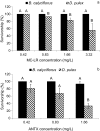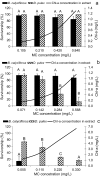Effects of secondary metabolites produced by different cyanobacterial populations on the freshwater zooplankters Brachionus calyciflorus and Daphnia pulex
- PMID: 30815809
- PMCID: PMC6476996
- DOI: 10.1007/s11356-019-04543-1
Effects of secondary metabolites produced by different cyanobacterial populations on the freshwater zooplankters Brachionus calyciflorus and Daphnia pulex
Abstract
Cyanobacterial blooms in eutrophic water bodies are a worldwide problem. Combined effects of mixtures of secondary metabolites produced by different cyanobacterial species on aquatic fauna are still not well recognised. We compared the survivorship of Brachionus calyciflorus Pallas (Rotifera) and Daphnia pulex Leyding (Cladocera) exposed to pure microcystin LR (MC-LR), anatoxin-a (ANTX) and to five extracts obtained from bloom-forming cyanobacteria Microcystis, Planktothrix and Dolichospermum. The obtained results revealed different response of the organisms to high concentrations of pure MC-LR, ANTX and complex cyanobacterial extracts. The extracts' toxicity to invertebrates was higher than that exerted by pure cyanotoxins and was dependent on the composition of cyanobacterial metabolites: Microcystis spp. extract containing anabaenopeptins A and B, aeruginosamide, four variants of cyanopeptolins and five MCs was not toxic to either of the organisms, whereas Planktothrix agardhii extract (I), containing anabaenopeptins A, B, F, 915, oscillamide Y, five different aeruginosins and four variants of MC was more toxic to daphnids than to rotifers. The extracts of another P. agarhdii (II) biomass and two different biomass samples of Dolichospermum spp. also affected survivorship of the rotifer and cladoceran, however, to various extent. It strongly suggests that non-ribosomal oligopeptides, other than MCs, had essential contribution to the observed toxicity to invertebrates and their effects on particular species or populations can vary depending on the secondary metabolite profiles of cyanobacteria.
Keywords: Anabaenopeptins; Anatoxin-a; Cyanopeptolins; Microcystins; Zooplankton.
Conflict of interest statement
The authors declare that they have no conflict of interest.
Figures



Similar articles
-
The Effects of Cyanobacterial Bloom Extracts on the Biomass, Chl-a, MC and Other Oligopeptides Contents in a Natural Planktothrix agardhii Population.Int J Environ Res Public Health. 2020 Apr 22;17(8):2881. doi: 10.3390/ijerph17082881. Int J Environ Res Public Health. 2020. PMID: 32331227 Free PMC article.
-
Combined effects of microcystin and nitrite on the growth, lipid peroxidation, and antioxidant responses of the freshwater rotifer Brachionus calyciflorus.Aquat Toxicol. 2017 Nov;192:78-88. doi: 10.1016/j.aquatox.2017.09.013. Epub 2017 Sep 14. Aquat Toxicol. 2017. PMID: 28934643
-
Cyanobacterial anabaenopeptin-B, microcystins and their mixture cause toxic effects on the behavior of the freshwater crustacean Daphnia magna (Cladocera).Toxicon. 2021 Jul 30;198:1-11. doi: 10.1016/j.toxicon.2021.04.023. Epub 2021 Apr 26. Toxicon. 2021. PMID: 33915136
-
Structure, Toxicity, Prevalence, and Degradation of Six Understudied Freshwater Cyanopeptides.Toxins (Basel). 2025 May 8;17(5):233. doi: 10.3390/toxins17050233. Toxins (Basel). 2025. PMID: 40423316 Free PMC article. Review.
-
Negative Effects of Cyanotoxins and Adaptative Responses of Daphnia.Toxins (Basel). 2022 Nov 7;14(11):770. doi: 10.3390/toxins14110770. Toxins (Basel). 2022. PMID: 36356020 Free PMC article. Review.
Cited by
-
Anabaenopeptins: What We Know So Far.Toxins (Basel). 2021 Jul 27;13(8):522. doi: 10.3390/toxins13080522. Toxins (Basel). 2021. PMID: 34437393 Free PMC article. Review.
-
Comparative Ecotoxicological Effects of Cyanobacterial Crude Extracts on Native Tropical Cladocerans and Daphnia magna.Toxins (Basel). 2025 Jun 2;17(6):277. doi: 10.3390/toxins17060277. Toxins (Basel). 2025. PMID: 40559855 Free PMC article.
-
Anabaenopeptins from Cyanobacteria in Freshwater Bodies of Greece.Toxins (Basel). 2021 Dec 21;14(1):4. doi: 10.3390/toxins14010004. Toxins (Basel). 2021. PMID: 35050981 Free PMC article.
-
Phytoplankton of the Curonian Lagoon as a New Interesting Source for Bioactive Natural Products. Special Impact on Cyanobacterial Metabolites.Biomolecules. 2021 Aug 2;11(8):1139. doi: 10.3390/biom11081139. Biomolecules. 2021. PMID: 34439804 Free PMC article.
-
Biotests in Cyanobacterial Toxicity Assessment-Efficient Enough or Not?Biology (Basel). 2023 May 12;12(5):711. doi: 10.3390/biology12050711. Biology (Basel). 2023. PMID: 37237524 Free PMC article. Review.
References
-
- PN-ISO 10260 (2002) Water quality. Measurement of biochemical parameters. Spectrophotometric determination of chlorophyll-a. PWN Warszawa (in Polish)
-
- Baumann HI, Jüttner F. Inter-annual stability of oligopeptide patterns of Planktothrix rubescens blooms and mass mortality of Daphnia in Lake Hallwilersee. Limnologica. 2008;38:350–359. doi: 10.1016/j.limno.2008.05.010. - DOI
MeSH terms
Substances
LinkOut - more resources
Full Text Sources
Miscellaneous

